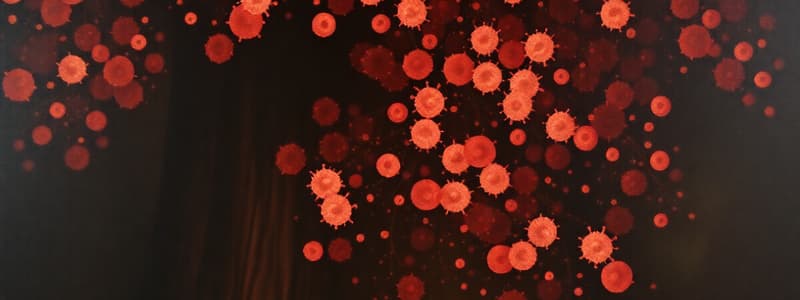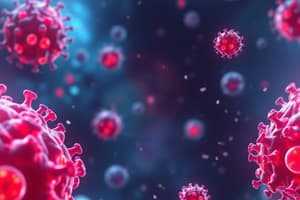Podcast
Questions and Answers
A compromised innate immune system will have no impact on adaptive immune responses.
A compromised innate immune system will have no impact on adaptive immune responses.
False (B)
After the destruction of an antigen, the immune response continues to amplify indefinitely, ensuring complete eradication.
After the destruction of an antigen, the immune response continues to amplify indefinitely, ensuring complete eradication.
False (B)
Tolerance is the capability of the immune system to react to self-antigens while remaining nonreactive to foreign antigens encountered.
Tolerance is the capability of the immune system to react to self-antigens while remaining nonreactive to foreign antigens encountered.
False (B)
Dendritic cells contribute exclusively to adaptive immune responses, while other cell types handle innate immunity.
Dendritic cells contribute exclusively to adaptive immune responses, while other cell types handle innate immunity.
Adaptive immunity can become more effective through the recruitment and activation of innate immunity, increasing efficiency.
Adaptive immunity can become more effective through the recruitment and activation of innate immunity, increasing efficiency.
The innate immune response relies solely on epithelial barriers and phagocytic cells to maintain internal homeostasis.
The innate immune response relies solely on epithelial barriers and phagocytic cells to maintain internal homeostasis.
Adaptive immune responses are activated immediately upon encountering a pathogen, acting as the first line of defense.
Adaptive immune responses are activated immediately upon encountering a pathogen, acting as the first line of defense.
Innate immune mechanisms are activated only after the adaptive immune system is triggered.
Innate immune mechanisms are activated only after the adaptive immune system is triggered.
Inflammation, initiated by the innate immune system, plays no role in the development of diseases like atherosclerosis or rheumatoid arthritis.
Inflammation, initiated by the innate immune system, plays no role in the development of diseases like atherosclerosis or rheumatoid arthritis.
The skin's acidic environment and antibacterial proteins like amylase promote colonization of microorganisms.
The skin's acidic environment and antibacterial proteins like amylase promote colonization of microorganisms.
The innate immune system relies on the production of antibodies to target specific pathogens upon initial exposure.
The innate immune system relies on the production of antibodies to target specific pathogens upon initial exposure.
The body's ability to mount a defense against specific pathogens or foreign substances, preventing the initiation of disease, is known as immunocompetence.
The body's ability to mount a defense against specific pathogens or foreign substances, preventing the initiation of disease, is known as immunocompetence.
Inflammatory processes and the skin act as the body's initial defense; this confers adaptive immunity to the host.
Inflammatory processes and the skin act as the body's initial defense; this confers adaptive immunity to the host.
The immune system is capable of distinguishing between foreign substances and the body's own cells through recognition of molecular patterns.
The immune system is capable of distinguishing between foreign substances and the body's own cells through recognition of molecular patterns.
A suppressed immune response leads directly to immediate hypersensitivity reactions.
A suppressed immune response leads directly to immediate hypersensitivity reactions.
The adaptive immune response is activated before the innate immune response to quickly eradicate infections.
The adaptive immune response is activated before the innate immune response to quickly eradicate infections.
An immune system that cannot properly regulate itself may lead to autoimmune diseases.
An immune system that cannot properly regulate itself may lead to autoimmune diseases.
Maintaining internal homeostasis relies on the isolated actions of individual immune mechanisms.
Maintaining internal homeostasis relies on the isolated actions of individual immune mechanisms.
Active immunity is acquired when the host does not mount an immune response to an antigen.
Active immunity is acquired when the host does not mount an immune response to an antigen.
Active immunity is generally short-lasting, typically only providing protection for a few weeks.
Active immunity is generally short-lasting, typically only providing protection for a few weeks.
Immunization is defined as the process by which passive immunity is acquired through the administration of a vaccine.
Immunization is defined as the process by which passive immunity is acquired through the administration of a vaccine.
Passive immunity is transferred from another source, giving short-term protection.
Passive immunity is transferred from another source, giving short-term protection.
Infants receive immunoglobulin A (IgA) antibodies from the mother via the placenta.
Infants receive immunoglobulin A (IgA) antibodies from the mother via the placenta.
Cytokines facilitate communication between cells of the immune system, initiating effector responses.
Cytokines facilitate communication between cells of the immune system, initiating effector responses.
Chemokines are a subset of antigens involved in immune and inflammatory responses.
Chemokines are a subset of antigens involved in immune and inflammatory responses.
Memory B and T lymphocytes contribute to active immunity by remaining dormant after the first exposure and activating upon a second, unrelated exposure.
Memory B and T lymphocytes contribute to active immunity by remaining dormant after the first exposure and activating upon a second, unrelated exposure.
The complement system is initiated by an antigen-antibody complex, leading to decreased bacteria aggregation.
The complement system is initiated by an antigen-antibody complex, leading to decreased bacteria aggregation.
Adaptive immunity involves interactions between the immune system and foreign pathogen antigens, acting as the initial line of defense against infection.
Adaptive immunity involves interactions between the immune system and foreign pathogen antigens, acting as the initial line of defense against infection.
Lymphocytes in adaptive immunity lack the ability to 'remember' specific pathogens, resulting in a similar immune response during repeat exposures.
Lymphocytes in adaptive immunity lack the ability to 'remember' specific pathogens, resulting in a similar immune response during repeat exposures.
Humoral immunity is primarily a defense against intracellular microbes, mediated by the activation of T lymphocytes.
Humoral immunity is primarily a defense against intracellular microbes, mediated by the activation of T lymphocytes.
Antigens, or immunogens, are substances or molecules recognized as 'self' by the body, triggering antibody production by T lymphocytes.
Antigens, or immunogens, are substances or molecules recognized as 'self' by the body, triggering antibody production by T lymphocytes.
Antigens, typically small molecules less than 5,000 Da, primarily consist of monosaccharides and fatty acids.
Antigens, typically small molecules less than 5,000 Da, primarily consist of monosaccharides and fatty acids.
Receptors on the surface of erythrocytes specifically recognize and bind to antigens, initiating an immune response.
Receptors on the surface of erythrocytes specifically recognize and bind to antigens, initiating an immune response.
Epitopes, also known as antigenic determinants, are uniform molecular shapes found on all antigens, enabling broad immune recognition.
Epitopes, also known as antigenic determinants, are uniform molecular shapes found on all antigens, enabling broad immune recognition.
A single antigen can only possess one epitope, limiting its ability to stimulate diverse T and B lymphocyte responses.
A single antigen can only possess one epitope, limiting its ability to stimulate diverse T and B lymphocyte responses.
Due to their complex structure, bacterial cell walls usually present only a limited number of epitopes to the immune system.
Due to their complex structure, bacterial cell walls usually present only a limited number of epitopes to the immune system.
Flashcards
Immune System
Immune System
The body's defense mechanism against pathogens and foreign substances.
Innate Immunity
Innate Immunity
The body's first line of defense, providing immediate, non-specific responses.
Adaptive Immunity
Adaptive Immunity
A specific defense mechanism that evolves over time to target specific pathogens.
Immune Response
Immune Response
Signup and view all the flashcards
Pathogens
Pathogens
Signup and view all the flashcards
Immunodeficiency
Immunodeficiency
Signup and view all the flashcards
Autoimmune Diseases
Autoimmune Diseases
Signup and view all the flashcards
Homeostasis
Homeostasis
Signup and view all the flashcards
Innate Immune Response
Innate Immune Response
Signup and view all the flashcards
Phagocytic Cells
Phagocytic Cells
Signup and view all the flashcards
Epithelial Barriers
Epithelial Barriers
Signup and view all the flashcards
Inflammatory Response
Inflammatory Response
Signup and view all the flashcards
Adaptive Immune Response
Adaptive Immune Response
Signup and view all the flashcards
Dendritic Cells
Dendritic Cells
Signup and view all the flashcards
Self-Tolerance
Self-Tolerance
Signup and view all the flashcards
Cytokines
Cytokines
Signup and view all the flashcards
Antigen-Antibody Complex
Antigen-Antibody Complex
Signup and view all the flashcards
Complement System
Complement System
Signup and view all the flashcards
Epitopes
Epitopes
Signup and view all the flashcards
Humoral Immunity
Humoral Immunity
Signup and view all the flashcards
Antigen
Antigen
Signup and view all the flashcards
Immunoglobulin
Immunoglobulin
Signup and view all the flashcards
Lymphocytes
Lymphocytes
Signup and view all the flashcards
Macromolecules
Macromolecules
Signup and view all the flashcards
Active Immunity
Active Immunity
Signup and view all the flashcards
Passive Immunity
Passive Immunity
Signup and view all the flashcards
Immunization
Immunization
Signup and view all the flashcards
Memory B and T Lymphocytes
Memory B and T Lymphocytes
Signup and view all the flashcards
Booster Vaccines
Booster Vaccines
Signup and view all the flashcards
IgG Antibodies
IgG Antibodies
Signup and view all the flashcards
Chemokines
Chemokines
Signup and view all the flashcards
Study Notes
Immunity Overview
- The human body constantly encounters potentially harmful microorganisms and foreign substances.
- The immune system distinguishes between self and foreign substances.
- Innate immunity is the body's first line of defense, comprising the skin and its epithelial layers, along with inflammatory processes.
- Adaptive immunity develops slowly and results in the creation of antibodies targeting specific substances for future encounters.
- Immunity is the body's ability to resist disease-causing pathogens.
- Immunodeficiency and hypersensitivity occur when the immune system is not functioning optimally.
Immunity Types
- Innate immunity: Immediate response to pathogens; utilizes physical barriers, cellular components (phagocytes), and plasma proteins.
- Adaptive immunity: Develops slowly; recognizes specific antigens; characterized by cellular (T cells), and humoral (B cells) responses; involves memory.
Overview of Immunity
- The immune system's multi-faceted response is crucial to maintaining homeostasis.
- Inappropriate or overactive responses lead to disorders like immunodeficiency or hypersensitivity.
Active vs Passive Immunity
- Active immunity: Acquired through exposure, either naturally (infection) or artificially (vaccination); results in long-lasting immunological memory.
- Passive immunity: Acquired through transfer of antibodies (e.g., mother to infant through the placenta or breast milk) or immunoglobulins; short-lived protection.
Cytokines
- Cytokines are small proteins that mediate communication between immune cells.
- Chemokines direct leukocyte migration.
- Interleukins regulate immune responses, including those related to inflammation.
- Interferons play a role in antiviral responses and inflammation regulation.
- TNF-α is a pro-inflammatory cytokine.
Pathogen Recognition
- Innate immunity relies on pathogen-associated molecular patterns (PAMPs), recognized by pattern-recognition receptors (PRRs) on immune cells.
- PAMPs are structures commonly found on pathogens.
Epithelial Barriers
- The skin, lining of the respiratory, gastrointestinal, and urogenital tracts form physical barriers against pathogens.
- These barriers also employ chemical and mechanical defenses to control microbial growth and invasion.
Cells of Innate Immunity
- Neutrophils: Abundant phagocytic cells that respond swiftly to infections.
- Macrophages: Phagocytic cells which also serve antigen-presenting functions promoting adaptive immune responses.
- Dendritic cells: Bridge innate and adaptive immunity; take up antigens and present them to T cells.
- Natural killer cells (NK cells): Cytotoxic lymphocytes responsible for eliminating infected or abnormal cells.
Cells of Adaptive Immunity
- Lymphocytes: Key components of adaptive immunity.
- B cells: Produce antibodies forming humoral immunity.
- T cells: Mediate cellular immunity.
- Antigen-Presenting Cells (APCs): Present antigens to lymphocytes initiating adaptive immunity.
Lymphoid Organs
- Thymus: Site of T lymphocyte maturation.
- Lymph nodes: Trap and process antigens, facilitating adaptive immune responses.
- Spleen: Filters pathogens from blood and initiates immune responses.
- Mucosa-associated lymphoid tissues (MALT): Respond to pathogens in mucosal membranes.
Immunity and Special Populations
- Neonates benefit from passive immunity from maternal antibodies.
- Aging can impact immune function; causing weakened adaptive immunity.
Hypersensitivity Reactions
- Type 1 (Anaphylactic): Immediate hypersensitivity reactions triggered by antigen binding to IgE; activates mast cells and basophils.
- Type 2 (Cytotoxic): Antibody-mediated destruction of cells.
- Type 3 (Immune Complex): Immune complexes deposit in tissues triggering inflammation.
- Type 4 (Cell-Mediated): Delayed hypersensitivity reactions; caused by T cells responses to antigens.
Studying That Suits You
Use AI to generate personalized quizzes and flashcards to suit your learning preferences.




